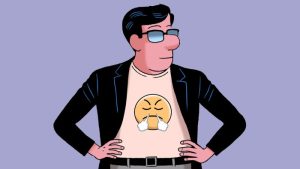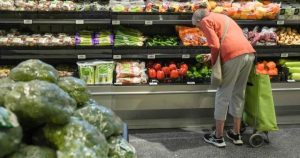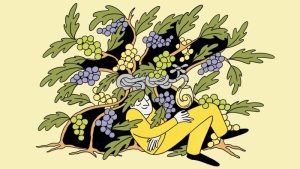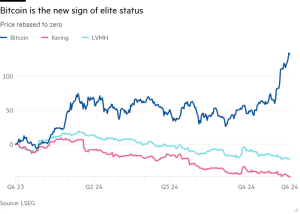What I learned while being bedbound
I’m on my way to the post office when it happens. It’s two weeks before Christmas, 2022. It’s cold, early. Commuters move towards me. My BBC alert announces that it’s the first day of the nurses’ strike. Passing the Tube station, taking my next step, I trip and my throat thickens, my ears fill and I black out. When the noise returns, I open my eyes and I’m lying in the street. I look down and my left leg looks wrong. The fall has turned it half a notch to the right. Hours later, an ambulance finally arrives. Going over each bump in the road, I take an inhalation of nitrous oxide to take the edge off the pain.
It was a femoral neck fracture, or broken upper-thigh bone. The femur is the longest and largest bone in the body and the hardest to break. It requires 7in of titanium and stainless steel to fix it. The tripping over has given me a pretty good hammering. After surgery and 10 days in hospital, I am sent home and confined to the bedroom I share with my husband, at a time usually spent running between Liberty’s Christmas bauble department, Ubering kids between friends’ houses and slogging Brussels sprouts and turkey accoutrements inside on one of the 287 trips it takes to empty the car boot. Not this year.

Instead, I embark upon a period of convalescence.
Unlike in a pandemic, unifying through the sense of collective isolation, I am alone. I miss my family. I listen to their laughter downstairs, their dinner-table discussion, hear the radio on in the kitchen and the front door slam when they leave. I read the books I am given, eat the meals I am brought and surrender to life on other people’s agendas. I study medical papers on post-fracture morbidity rates in geriatric females (a macabre moment; I am not there yet), make friends with the entire orthopaedic staff at Imperial College and sleep during the day. I watch the odd film. I look at the hook on the back of my bedroom door. I stare into space.
Convalescence is a state most of us have experienced at certain points in our lives. But the version of it in which we are largely immobile, often horizontal, and living from a bed or armchair, often imposed upon us and medically necessary in order to recover, is a qualitatively different experience. Sleep restores us and boredom creates introspection. This knowledge is powerful because, unlike sensory knowledge (reading, watching TV, someone’s facial expression to tell us what their mental state is), it reveals things about ourselves that no one else can. It literally tells us what’s on our mind.
In the awake periods, I pay attention to these thoughts and feelings, allowing them to immunise me against the ebb and flow of daily patterns. Over the nine weeks I spend confined to my bed, my relationship with my home, body and way of being in the world changes. It’s a turning point I haven’t anticipated and leaves me curious about the history of the experience of convalescence.
For some it has produced bouts of creative expression. In 1925, at the age of 18, Frida Kahlo was on a bus involved in a head-on collision, which resulted in her being encased in plaster and bound to her bed. It caused her to abandon her aspiration to a career in medicine, but the isolation deepened her artistic confidence. She went on to paint Self-Portrait Wearing a Velvet Dress, which presents the artist locked in a frontal, steadfast gaze, with an intensity that combines the pain of both physical trauma and separation from her lover Alejandro Gómez Arias (she made the painting for him in order to win him back, successfully).


In 1998, Tracey Emin’s My Bed famously evoked a vodka-fuelled psychosexual breakdown. Today, her relationship with the bed is different. In June 2020, after the discovery of an aggressive squamous cell cancer in her bladder, and having undergone a massive surgery that July to save her life, Emin was unable to paint. Instead, she made photographic self-portraits to record her experiences (We All Bleed shows a postoperative Emin in surgical pants, with IV lines and a urostomy bag). Once she was strong enough to return to painting, her I Wanted To Be Clean and You Promised Me Love joined a series of paintings about love, except now with the energetic determination to live (Emin no longer drinks or smokes).
We spend one-third of our lives in bed, sleeping. But it’s a space that is loaded with significance beyond that; to be in bed is to be in a state of vulnerability and physical surrender. Body fixed, mind somewhere else. Emin’s photographs and subsequent paintings, born out of an extended period of being held in this space, seem to me to express the possibility for transformation.
Some actively seek out intense physical rest, whether for a love of sleep or just the ease of being horizontal. In the 1950s, First Lady Mamie Eisenhower chose to hold morning staff meetings from her pink-ruffled bed. In Ottessa Moshfegh’s My Year of Rest And Relaxation, her misanthropic protagonist devises a plan to recover from the death of her parents through a chemically induced hibernation. The Proustian moment famously depicted in À la recherche du temps perdu (In Search of Lost Time) – the taste of a madeleine sponge cake dipped into tea – was written from within the cork walls of Proust’s bedchamber on Boulevard Haussmann in Paris. This confinement was largely down to Proust’s predisposition to working in bed due to suffering chronic illness from the age of nine.
It’s understood that rest can change us. “When we are recovering we are in a state of repair,” says Nicole Vignola, a cognitive neuroscientist and brain health specialist. “The brain reorganises itself, forming new neural connections. During convalescence, you’re essentially reorganising the pathways in your brain without the external influence that was previously pushing you to be a particular way. You can quite literally just think everything internally from your internal state. A lot of creative processes are fuelled by the emotional impact of situations.”


The legacy of confinement, for others, has simply been that they made work in order to share their experience, as an integral part of the healing process. In the early 1970s, the American artist William Scott, who is now in his early 60s, was badly burnt when his shirt caught fire at his home in Bayview-Hunters Point in San Francisco. He underwent multiple skin grafts while confined in the burns unit at San Francisco General Hospital. The painting of his body, Before and After, he calls it, shows his body with the scar, and without, as a reborn version of himself. Tom di Maria, Scott’s gallerist and executive director of Creative Growth Center, the centre for artists with disabilities based in Oakland, says that “it was like when the solutions in the real world did not exist, the painting would offer the path forward. So his response to convalescence is to erase it in his paintings.”
My accident gave way to introspection. I didn’t consciously stop making to-do lists, I just stopped making them. My attitude to things became less rigid, easier (I’m currently in recovery from baking, having come to believe that it is a thankless and punitive pastime). I ask fewer questions in conversation, not because I’ve suddenly lost enthusiasm for life – I just don’t feel like I have to cling on to it so tightly. I have begun to consider earning a living doing something else beyond editorial publishing, where I’ve worked for 25 years. Up until that cold mid-December morning, my relationship with my body was careless, assumed. Attempting the simple (now painful and seemingly impossible) daily task of bending down to put on a shoe, I’m grateful for anything I can navigate independently.
Did my relationship to my surroundings change as a result of confinement? There’s no moral to the story here. Sure, now I bake less, and have a few more bedside bookshelves. I still cherish the first cup of tea of the day in bed and I’ve always been lazy about opening the front door. The impact of resting my body, after wading through the initial despair-slash-boredom period, of sleep and respite is, however, where the real magic happens. That transformative space that a brain needs for processing, learning and extracting meaning is what convalescence gave me. It also left me with a bionic leg that is punk, or so my friend the newsagent tells me.
#learned #bedbound








